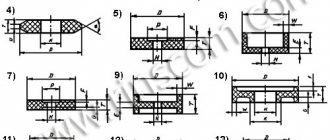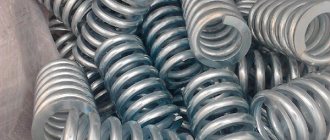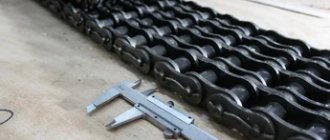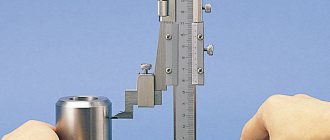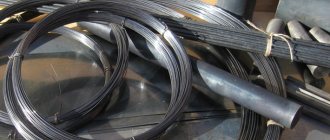What is indicated in the labeling
The main characteristics taken into account when choosing wheels are their type, type of abrasive, bond, hardness and grain size. In this case, hardness and structure for many types of processing play a more important role than the abrasive material.
Product labeling contains the following information:
- circle type;
- product size;
- abrasive material;
- graininess of the circle;
- product hardness;
- structure;
- binding material;
- permissible rotation speed;
- circle accuracy class;
- imbalance of the circle.
When choosing a wheel, it is necessary to take into account that the markings made in accordance with various GOSTs differ in the designations of grain size, hardness and other parameters. In addition, manufacturers use different markings for their wheels, excluding some parameters and using old and new designations. Let's give an example of decoding
1 – 25A – white electrocorundum is used as an abrasive; 2 – average abrasive grain size 370 µm (F46); 3 – medium-soft hardness, type L; 4 - middle structure (6); 5 – ceramic binder (V); 6 – maximum rotation speed 35 m/s; 7 — accuracy category B; 8 – 3rd class of imbalance.
This is interesting: How and with what to solder stainless steel at home: tips, videos, photos
Types and characteristics of grinding wheels
The grinding wheels used today have a fundamentally identical design: in general, it is a body of rotation with a different profile, formed from an array of abrasive grains with a binder, and having a mounting hole in the center for mounting on the spindle (shaft) of the machine/machine. The wheel is made by gluing abrasive grains of a certain size using bonds, which provide the necessary strength to the product and prevent it from breaking under the influence of centrifugal forces during rotation.
Wheels are classified according to their profile (section), type and grain size of the abrasives used, type of binding material and some characteristics.
The following types of grinding powders are used as abrasive materials:
- Electrocorundum (marking “A”) - normal (grades 12A – 16A), white (grades 22A – 25A), chromium (grades 32A – 34A), titanium (grades 37A) and zirconium (grades 38A, can be marked with the letter “Z”) ;
- Silicon carbide (marked “C”) - black (grades 52С – 55С) and green (grades 62 – 64С).
There are grinding wheels that use diamond, CBN and other materials as an abrasive, but they have a different design (metal base on which a layer of abrasive is applied) and characteristics, and are not discussed in this article.
The grain size of the abrasives used for the manufacture of wheels lies within the range of F36 - F220 according to GOST R 52381-2005 (corresponds to the international specification FEPA - Federation of European Producers of Abrasives, European Federation of Abrasives Manufacturers) and M63 - M10 according to GOST 3647-80 (currently time partially cancelled). In wheels with abrasives F36 - F220, the average grain size ranges from 58 - 525 microns, and with abrasives M63 - M10 - from 7 to 63 microns.
When forming a grinding wheel, the following types of bonds can be used:
- Ceramic (marking V, obsolete - K);
- Bakelite (marking B, B4, BF, obsolete - B, B4, BU);
- Vulcanite (marked R, obsolete - B).
Types of Abrasive Wheel Bonds
Ceramic bonds are inorganic components based on various types of clays with the addition of feldspar, quartz and other substances. After firing, the ceramic binder provides the wheel with the necessary rigidity, wear resistance and strength (including temperature), but it has increased fragility. These types of wheels are not used in machines and machines that process shock loads.
Bakelite binder is a resin (bakelite) that can be used in its pure form, with reinforcing additives (marked BF/BU) or with graphite (marked B4/B4). Due to its elasticity, the bakelite bond is resistant to shock loads, but does not withstand high temperatures and aggressive environments (including some types of cutting fluids, coolants). Also, wheels on a bakelite bond have good self-sharpening properties - worn grain is relatively easily torn off from the bond, exposing new grain, which ensures stable abrasive properties.
Vulcanite bond is a vulcanized rubber (actually high-density rubber or ebonite) that can have various additives to increase strength and chemical resistance. Currently, this type of grinding wheel is the least used.
Grinding wheels can be molded with different ratios of abrasive grain and binder, which characterizes their structure, which can be of the following types:
- Dense (marking from 1 to 4);
- Medium (marking 5 - 7);
- Open (marking 8 - 10);
- Highly porous (marking 11, 12).
The higher the number, the less dense the structure of the circle, and the greater the distance between the grains.
Depending on the type of bond and density, the wheels can have different hardness - a characteristic indicating the strength of the bond's holding of abrasive grains. The higher the hardness, the stronger the grain is held in the bond, and the more difficult it is to break out when grinding the surface of the product. In terms of hardness, the circle can be of the following types:
- Very soft (BM1, BM2; F, G);
- Soft (M1 – M3; H, I, J);
- Medium soft (SM1, SM2; K, L);
- Middle (C1, C2; M, N);
- Medium-hard (ST1 – ST3; O, P, Q);
- Solid (T1, T2; R, S);
- Very hard (VT; T, U);
- Extremely hard (HH; V–Z).
The alphanumeric hardness marking corresponds to the old standard GOST 19202-80 (not used today), in Latin letters - to the standard GOST R 52587-2006.
Finally, grinding wheels can have accuracy classes “AA”, “A” and “B”, and unbalance classes from 1 to 4.
Grinding wheels are divided into several types according to their profile (section):
Grinding wheel profiles
- Type 1 - straight profile (PP);
- Type 2 - ring (K);
- Type 3 - with one-sided conical profile (3P);
- Type 4 - with double-sided conical profile (2P);
- Type 5 - with one-sided groove (PV);
- Type 6 - cylindrical cup (CC);
- Type 7 - with double-sided undercut (DVD);
- Type 10 - with double-sided groove and hub (PVDS);
- Type 11 - conical cup (CC);
- Type 12, 14 - disc-shaped (T, 1T);
- Type 20 - with sampling;
- Type 21 - with double-sided sampling;
- Type 22 - with recess and undercut;
- Type 23 - with recess and recess on one side (PVK);
- Type 24 - with recess and recess on one side and with a recess on the opposite side;
- Type 25 - with recess and recess on one side and recess on the opposite side;
- Type 26 - with recess and recess on both sides (PVDK);
- Type 35 - straight profile end;
- Type 36 - straight profile with pressed-in fasteners (PN);
- Type 37 - ring profile with pressed-in fasteners;
- Type 38 - with one-sided hub;
- Type 39 - with double-sided hub.
All characteristics, geometric shape and dimensions of grinding wheels for stationary electrical machines and machine tools in Russia are regulated by the GOST R 52781-2007 standard. Previously, the GOST 23182-78 standard for wheels for hand-held machines was in force, but it has now been cancelled.
A separate group includes wheels for hand-held grinding machines, made of non-woven materials with abrasive grain applied to them. These tools are manufactured according to the enterprises’ own standards; today they are presented in large quantities to perform a wide range of operations.
Classification of abrasive wheels
Disks are classified into the following types:
- with undercut (PV – for cylindrical grinding);
- double-sided conical (PVDK);
- straight profile (PP – universal circle);
- with a conical one-sided or two-sided groove;
- ring (K – suitable for flat grinding);
- disc-shaped (T);
- cup conical or cylindrical;
- with a double-sided conical profile (2P: scope of application – thread grinding, slot grinding, gear grinding).
Abrasives and grit
The abrasive material is indicated by alphanumeric markings. Thus, electrocorundum is marked with the letter A. White electrocorundum - from 22A to 25A, normal from 12A to 16A, chromium from 32A to 34A. There are also titanium electrocorundum (37A), zirconium (38A) and other varieties. The higher the number, the higher the quality of the material. Silicon carbide is designated by the letter C and is divided into black (from 52C to 55C) and green (62C – 64C).
Diamond wheels are marked as follows:
- AC2 – circle of normal strength.
- AC4 – increased strength.
- AC6 is a high-strength abrasive.
- AC32 is a monocrystalline abrasive.
The grain size determines the cleanliness of the resulting surface. The marking indicates the size (width) of the grain. In accordance with the old GOST 3647-80, this parameter is indicated in units equal to micrometers divided by 10 (10 = 100 microns). Micropowders are marked with the letter M. According to the new GOST R 52381-2005, the grain size is indicated by the letter F and a numerical designation. Moreover, unlike the old standard, the larger the number, the smaller the abrasive grain size.
Type of abrasive material
The most popular and common materials used in the manufacture of grinding wheels include:
- Electrocorundum. When purchasing such a circle, you can see white, titanium, chrome and zirconium options. The main disc used is white electrocorundum, which is highly self-sharpening. By working with it you can achieve a more even and smooth surface.
- Silicon carbide. There are black and green tones, this circle differs in structure and degree of fragility - it is harder and more durable than the first type described above. Area of application: working with hard alloys, porcelain and marble.
- Elbor. This type of grinding wheel has the hardest abrasive material and high heat resistance. Elbor can be used for sharpening cutting tools and other parts that can be deformed by heat, as well as for working with hard metals.
- Diamond. Another hard type of abrasive wheel. It is used when working with hard materials, glass and ceramic surfaces. It is self-sharpening, but cubonite and CBN have greater heat resistance without compromising strength.
Regardless of the type of abrasive material, all wheels are characterized by the parameters of strength, wear resistance and heat resistance, however, when choosing, you should take into account the main parameter - hardness. The hardness characteristic is prescribed in the standards of GOST 2424 and is calculated using special tables.
For example, the type of grinding material for the 25A F180 K 7 V wheel is white corundum. There are other types of known abrasives:
- normal electrocorundum (13-16A);
- white (23-25A);
- chromium (33 and 34A);
- titanium only one (37A);
- zirconium is also one (38A);
- monocorundum (43-45A);
- black silicon carbide (53 and 54C);
- green silicon carbide (62-64C).
Hardness and other parameters
Hardness is the ability of the binder to keep the grains from being pulled out, which affects the ability to self-sharpen. There are a total of 8 hardness groups according to the table below.
The next parameter is the structure of the wheel, which implies the percentage of abrasive per unit volume. The dense structure is designated by numbers from 1 to 4, medium 5 – 7, open 8 – 10 and highly porous 11 and 12.
Next comes the link designation. Ceramic is designated by the letter V or K according to the old GOST, bakelite - V (B) and vulcanite R (B). Bakelite bond with hardener is designated BF (BU), with graphite filling B4 (B4). Accuracy class AA, A and B. The most accurate is AA, wheels of this class are used in automatic lines. And the last value is the class of tool mass imbalance. Indicated by numbers from 1 to 4. This parameter does not affect the balancing of the tool assembled with flanges.
Abrasive disc size
The marking of abrasive wheels by size is written as follows: DхТхН (where D is the outer diameter, T is the height, H is the diameter of the hole). The D parameter can reach a maximum size of 1100 mm, the H value can be up to 305 mm, and the T parameter varies from 0.18 mm to 250 mm.
The types of CBN and diamond discs are described in more detail in GOST 24747-90. The marking of the shape of such grinding wheels consists of three or four symbols indicating the cross-sectional shape of the body and layer, its location on the wheel, and also provides information about the design features of the body.
For example, 150x16x32 is the size of a 25A white electrocorundum abrasive wheel.
Reminder when choosing abrasive wheels:
- When choosing the diameter of the circle, you should take into account the number of spindle revolutions and the ability to provide optimal speed.
- The larger the diameter, the less specific wear of the circle. There are fewer grains on the working surface of small circles. So, during operation they wear out unevenly.
- When choosing a diamond wheel, you should take into account the width of the diamond-bearing layer. If used incorrectly, ledges may appear on the surface of the wheel.
This is interesting: Cold metal stamping: technology, types, equipment
Features of marking grinding products
The production of wheels is carried out in accordance with GOST; accordingly, their marking is also regulated by regulations. Typically, the main criteria for marking abrasive wheels are:
- Sanding material is a crumb of a special material that is characterized by high strength and good grinding properties.
- The size of the disk characterizes the diameter of the circle.
- Grain size – the degree of processing directly depends on it. The larger the grains, the more intensively and roughly the surface being treated is erased. Coarse grit is used when it is necessary to quickly remove a large amount of material and cut a large piece from a part. Fine is usually used for fine finishing, sanding and smoothing corners.
- Disc type - depends on the profile features of the new sanding wheel. Today there are 39 different types of profiles.
- Degree of hardness - this indicator has nothing to do with the hardness of the abrasive chips; it characterizes the ability of the binder material to hold grains on its surface and prevent them from tearing off during processing.
- Binder – indicates the material that acts as the base of the circle. A binder is necessary to form a circle of crumbs.
- Instability class - the accuracy of surface treatment depends on it. The higher the instability, the lower the quality of work. The reason for this is most often the irregular shape of the circle, uneven distribution of the binding material and displacement of the seat relative to the geometric center of the circle.
- Structure - indicates the ratio of the amount of abrasive and binding material, the presence of pores in the composition, the nature of the arrangement of grains and the uniformity of their distribution.
- Optimal rotation speed - calculated depending on the purpose of the emery, its structure, characteristics of the material used and shape. It is recommended to hold it to achieve optimal results.
In order to select the right tool, it is important to understand the features of the markings of grinding discs.
Structure and hardness index
The density of the structure of grinding wheels is indicated by the percentage of the volume of abrasive grains per unit volume of the wheel. The more abrasive, the denser the structure of the grinding wheel will be.
When sharpening a tool, a wheel with a less dense structure is better able to clean the surface of material particles, poses less risk of deformation and cools faster.
Often, specialists use disks of medium hardness, but it all depends on the type of work being performed, the coating being processed and the tool itself.
What are the structure numbers and volumes of abrasive in the grinding wheel:
- dense structures include units of measurement from 1 to 4;
- Average density includes numbers 5-8;
- to open – from 9 to 12;
- a highly porous structure is observed in circles with indicators 13, 14>.
However, do not confuse wheel hardness with abrasive hardness. According to GOST 2424, the hardness of a grinding wheel is distinguished by a capital letter.
According to GOST R 52587-2006, there are the following designations:
- very soft - letters F and G;
- to soft circles – H, I, J;
- medium softness includes markings K, L;
- averages are M, N;
- circles of medium hardness are designated by the letters O, P, Q;
- solids are designated as R and S;
- very hard – T, U;
- Extremely hard ones include V, W, X, Y, Z.
What grinding wheel hardness should I choose? This depends on many parameters - the characteristics of the material or surface being processed, physical properties, and, of course, the power of the grinding machine. If you need to maintain the exact shape of the material being processed, you should purchase a wheel with a high degree of hardness. Soft ones are used to prevent cracks and burns, also when grinding without additional liquid-lubricant cooling of the surface.
For example, let's take the same 25A grinding wheel, which has a hardness class of K and a structure of 7. This means that this disc is medium-soft and has a medium abrasive structure.
Bundle type
The bond is an indicator of the bonding of abrasive grains to each other. Modern grinding wheels have three types of bonds:
- V (ceramic, previously marked with the letter K);
- B (bakelite, formerly known as B4 and BU);
- R (volcanic, previously designated by the letter B).
Ceramic marked wheels have materials such as quartz, sand, clay, etc. mixed and ground in various proportions. Such circles are quite high-strength. However, they should not be used for power grinding of metal.
Bakelite or artificial resin wheels are highly elastic and heat resistant. Bakelite is often mixed with reinforcing elements, such as graphite.
The volcanic binder consists mainly of rubber; such wheels are used in certain processing industries.
Using the example of the 25A F180 K 7 V grinding wheel, we will consider the type of bond, where the designation V refers this disc to a ceramic bond.
Types of grinding wheels
According to the non-professional classification of grinding wheels, the following types are distinguished:
- Velcro discs
are made of sanding paper on a Velcro base, which is attached to the support using a self-adhesive backing. This material is considered consumable and is used in woodworking, metalworking, repair and construction. The Velcro sanding wheel is installed on a grinder or eccentric sander, as well as on a handmade drill. It is marked with a different color indicating the grain size. For example, brown is suitable for wood and metal, blue is suitable for stainless steel, and black can be used to process minerals. - The flap wheel
is fan-shaped, has good elasticity and easily adapts to any surface. It is mainly used for grinding pipes, fittings, and wood products. - A fiber grinding wheel
is a grinder equipment for processing surfaces made of ferrous and non-ferrous metals and steel. Used for cleaning weld seams and removing spatter. The fiber base for such discs is made by processing cellulose. - The diamond grinding wheel
is used for fine grinding of carbide materials, glass, ceramics, precious and semi-precious stones. The diamond blade has an optimal balance of fragility and strength and has a large working reserve.
